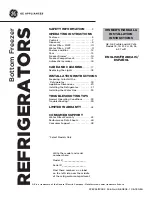
14
Defrosting
Refrigerator
The refrigerator automatically defrosts every time
the compressor stops.
Important
To avoid defrost water overflowing into the fridge,
periodically clean the water discharge hole in the
centre of the V shaped drip collector at the back of
the refrigerator compartment behind the fruit and
vegetable drawer. Use the special cleaner provided
which you will find already inserted into the
discharge hole (Fig. 12).
Fig. 12
Remember to wash the defrost cleaner in hot soapy
water at regular intervals. Dry thoroughly before
replacing.
D037
Freezer
The freezer compartment of this model is of the
«frost-free» type. This means that no frosting
occurs on the inner walls of the compartment or on
food during operation.
The absence of frosting is achieved by constant
circulation of cold air inside the compartment,
produced by an automatic fan blower.
The water produced by defrosting flows away - in
the case of both the freezer and refrigerator
compartments - through special drainage grooves
into a container positioned at the back of the
appliance above the compressor where it then
evaporates.
Attention!
«In the event of a power failure causing the temperature
within your freezer to rise, do not re-freeze the food
without checking its condition. The following guidelines
should assist you.»
Ice-cream: o
nce thawed should be discarded.
Fruits & Vegetables:
if soft should be cooked and used
up.
Breads & Cakes:
can be re-frozen without danger.
Shellfish
: should be refrigerated and used up quickly.
Cooked Dishes:
i.e. casseroles should be refrigerated
and used up.
Large Pieces of Meat:
can be re-frozen providing there
are still ice crystals remaining within them.
Small Joints:
should be cooked and can then be re-
frozen as cooked dishes.
Chicken:
should also be cooked and re-frozen as a
cooked dish.
Summary of Contents for ZFC 62/23 FF
Page 18: ......





































